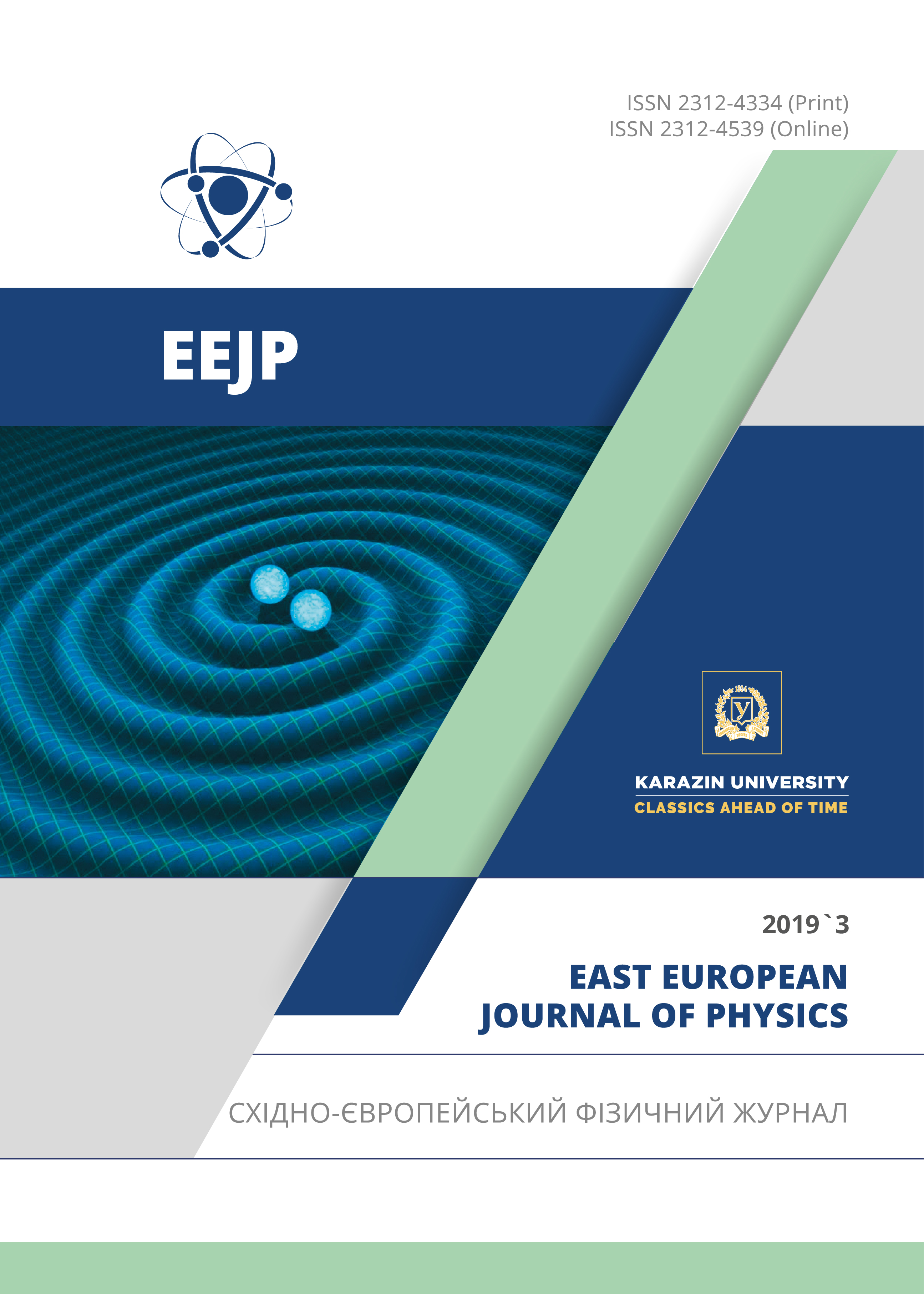The Investigation of Mechanisms of Fast Neutron Registration in Oxide Scintillators
Abstract
The contributions of gamma rays from the inelastic scattering reaction and the resonant reaction in the process of slowing down fast neutrons inside the oxide detector volume are investigated. For this the countable efficiency of the ZnWO4, CdWO4, Bi4Ge3O12 oxide scintillators in terms of pulses/neutron during the registration of the fast neutrons from a 239Pu-Be source was measured. It is assumed that the response of detectors during neutron moderation in oxide scintillators with an effective thickness of about 40—50 mm is formed by instantaneous gamma rays from inelastic, resonant inelastic scattering reactions, as well as delayed gamma rays from the capture reaction of resonance neutrons. The parameters of the nuclei, which determine the detector response — the density of the nuclear levels of the compound nuclei being formed, the widths of the resonance regions, the lifetimes of the excited nucleus state were considered. It was found that the registration of a cascade of gamma rays from the discharge of excited levels leads to a significant increase in the countable efficiency of the detector and, as a consequence, an increase in the sensitivity of the detector to fast neutrons. The measured response in terms of pulses/neutron for the ZWO detector — 64, for CWO — 36, for BGO — 2.5. The response of the detectors was recorded by the broadband tract with a time feedback of τ~```0.7 ns. The measured values of the efficiency are explained by the fact that, in our case, the reaction of inelastic scattering is the starting process, which starts the process of discharging nuclear long-lived (~``` 1–1000 ns) states excited in both inelastic scattering and in resonance capture reaction. The registration of the gamma-quanta from discharge leads to an increase the countable efficiency of the detector. The observed increase of the countable efficiency of the secondary gamma quanta is realized when neutrons are moderated inside the oxide detectors with a thickness of 40—50 mm or more. The measurement error of the registration efficiency was about 7%.
Downloads
References
M. Anelli, G. Battistoni, S. Bertolucci et al. Nucl. Inst. Meth. Phys. Res. A, 580, 368 – 372 (2007), DOI:
1016/j.nima.2007.08.005.
L. L. Nagornaya, V. D. Ryzhikov, B. V. Grinyov, L. A. Piven’, G. M. Onyshchenko and E. K. Lysetska, in: Abstracts IEEE Nuclear Science Symposium, (Drezden, Germany, 2008), pp. 1-3.
B. Grynyov, V. Ryzhikov, L. Nagornaya, G. Onishcenko, L. Piven’. US Patent N 8.058.624 B2 (15 November 2011).
V. D. Ryzhikov, B. V. Grinyov, G. M.Onyshchenko, L. A. Piven, O. K. Lysetska, O. D. Opolonin, S. A. Kostioukevitch and C. F. Smith, in: XVI SPIE Optical Engineering Proceedings, “Hard X-Ray, Gamma-Ray, and Neutron Detector Physics”, Editor(s): Arnold Burger; Larry Franks; Ralph B. James; Michael Fiederle (IEEE, San Diego, 2014), DOI: 10.1117/12.2058185.
V.D. Ryzhikov, S.V. Naydenov, G.M. Onyshchenko, L.A. Piven, T. Pochet and C.F. Smith, Nucl. Inst. Meth. Phys. Res. A, 903, 287–296 (2018), DOI: 10.1016/j.nima.2018.06.074.
B. Grinyov, V. Ryzhikov, G. Onyshchenko, I. Yakymenko, S. Naydenov, O. Opolonin and S. Makhota, in: Sixth International Conference “Engineering Of Scintillation Materials And Radiation Technologies”, (ISMART, Minsk, 2018), pp. 46.
V. Ryzhikov, G. Onyshchenko, I. Yakymenko, S. Naydenov, O. Opolonin and S. Makhota, in: XVII конференция по физике высоких энергий и ядерной физике, ННЦ ХФТИ НАН Украины, ИФВЭ и ЯФ, Харьков [XVII Conference on High Energy Physics and Nuclear Physics, NSC KIPT NAS of Ukraine], (IPHE&NP, Kharkiv, 2019), pp. 96, (in Russian).
Japan Atomic Energy Agency, Nuclear Data Center, in: https://wwwndc.jaea.go.jp/jendl/j40/j40nat.html, https://wwwndc.jaea.go.jp/jendl/j40/j40.html.
The Nuclear Reaction Data Centres Network (JANIS, NRDC), in: http://www.oecd-nea.org/janisweb.
O. Kazachkovskij, Atomic Energy, 83(1), 509-515 (1997).
G. Venkataraman, Dayashankar and J.S. Jayakar, Nuclear Instruments and Methods, 82, 49-50 (1970).
V. Ryzhikov, G. Onyshchenko, I. Yakymenko, S. Naydenov, A. Opolonin and S. Makhota, East Eur. J. Phys., 2, 11-18 (2019).
J.M. Blatt and V.F. Weisskopf, Theoretical Nuclear Physics. (Wiley, New York, 1952), pp.864.
T. Egidy and D. Bucurescu. Physical Review C, 72, 044311(1–22) (2005), DOI: 10.1103/Phys-RevC.72.044311.
Nuclear Data Sheets, in: https://www.journals. elsevier.com/nuclear-data-sheets.
M.C. Lederer and V.S. Shirley, editors, Table of isotopes, (Wiley-Blackwell, New Jersey, 1979), pp. 1632.
Citations
The Threshold of Detection of Fission Materials by ZnWO4 and Bi4Ge3O12 Scintillation Detectors
(2019) East European Journal of Physics
Crossref
Authors who publish with this journal agree to the following terms:
- Authors retain copyright and grant the journal right of first publication with the work simultaneously licensed under a Creative Commons Attribution License that allows others to share the work with an acknowledgment of the work's authorship and initial publication in this journal.
- Authors are able to enter into separate, additional contractual arrangements for the non-exclusive distribution of the journal's published version of the work (e.g., post it to an institutional repository or publish it in a book), with an acknowledgment of its initial publication in this journal.
- Authors are permitted and encouraged to post their work online (e.g., in institutional repositories or on their website) prior to and during the submission process, as it can lead to productive exchanges, as well as earlier and greater citation of published work (See The Effect of Open Access).








